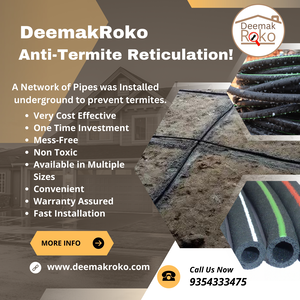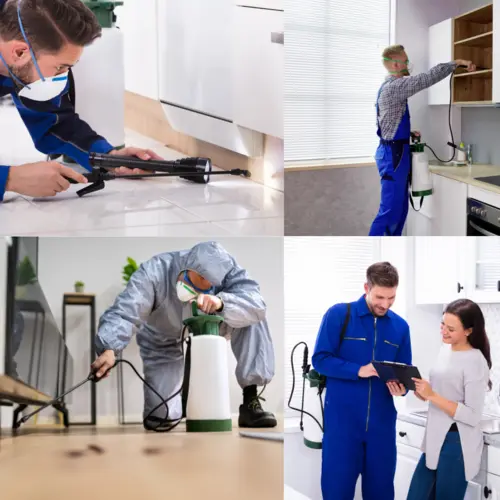Termites can cause significant damage to homes, leading to costly repairs. Thus, finding an effective and affordable termite treatment is crucial. In this blog post, we will compare the costs of two popular termite treatment methods: porous pipes and chemical treatments. We’ll explore the benefits and drawbacks of each, helping you make an informed decision to protect your home.
Understanding Termite Treatments
Before we dive into the cost comparison, let’s understand what are porous pipes and chemical treatments.
What Are Porous Pipes?
Anti termite reticulation pipes are a relatively new method for termite treatment. These pipes are installed around the perimeter of a building, allowing termiticide to be distributed evenly into the soil. The termiticide creates a barrier that prevents termites from entering the structure.

What Are Chemical Treatments?
Chemical treatments involve applying liquid termiticides directly to the soil around a building. This creates a chemical barrier that kills termites on contact and prevents them from accessing the structure

Cost Comparison: Porous Pipes vs. Chemical Treatments
Now, let’s compare the costs of these two methods. We will look at initial installation costs, maintenance, and long-term savings.
- Plan the layout of the underground pipes
- Dig trenches around the perimeter of your property
- Install the pipes and connect them to the main unit
- Fill the trenches and test the system for leaks
Initial Installation Costs
The initial installation cost is the first factor to consider. This includes the price of materials and labor.
Porous Pipes
The installation of these pipes can be more expensive initially. This is because it requires professional installation and the use of specialized materials. On average, homeowners can expect to pay between Rs 15/sqft – Rs 21/sqft for the installation of porous pipes. it is specifically depends on the size of the property.
Chemical Treatments
Chemical treatments tend to be less expensive initially. The cost largely depends on the size of the property and the type of termiticide used. Generally, homeowners may spend between Rs 7/sqft – Rs 10/sqft for a chemical treatment.
Maintenance Costs
Next, we need to consider maintenance costs. Both methods require regular maintenance to remain effective.
Porous Pipes
Anti Termite Reticulation System need to be checked and refilled with termiticide periodically. The frequency of maintenance depends on the type of termiticide used and the level of termite activity in the area. Typically, maintenance costs can range from Rs 2.5/sqft – Rs 3/sqft after every 3 year.
Chemical Treatments
Chemical treatments also require periodic reapplication to maintain effectiveness. The cost of reapplication can vary, but it usually falls between Rs 7/sqft – Rs 10/sqft rupees per year.
Long-Term Savings
Long-term savings are an essential consideration when comparing termite treatments. Effective termite prevention can save you from costly repairs in the future.
Porous Pipes
Although the initial installation and maintenance costs of these pipes are higher, they can offer significant long-term savings. Porous pipes provide a continuous barrier against termites, reducing the risk of infestation and damage over time. Consequently, you may spend less on repairs and additional treatments in the long run.
Chemical Treatments
Chemical treatments can be effective but may not provide the same level of long-term protection as porous pipes. Since termites can find ways to bypass the chemical barrier, you might need to invest in additional treatments or repairs, leading to higher long-term costs.
Effectiveness and Environmental Impact
Cost is a crucial factor, but effectiveness and environmental impact are also important.
Effectiveness
Both reticulation pipes and chemical treatments are designed to prevent termites, but their effectiveness can vary
Porous pipes
It creates a continuous barrier around your home, making it difficult for termites to enter. This method is generally more effective in the long term because it ensures even distribution of termiticide.
Chemical Treatments
Chemical treatments are effective initially but may lose potency over time. Additionally, if not applied correctly, termites can find gaps in the barrier, reducing effectiveness.
Environmental Impact
Considering the environmental impact of termite treatments is also essential.
Porous Pipes
These pipes use less termiticide overall because of the controlled distribution system. This reduces the environmental impact and lowers the risk of contaminating soil and groundwater.
Chemical Treatments
Chemical treatments often use larger quantities of termiticide, which can have a more significant environmental impact. Overuse of chemicals can lead to soil and water contamination, affecting local ecosystems.
Ease of Installation and Use
The ease of installation and use can influence your decision, especially if you prefer a less invasive treatment method.
Porous Pipes
Installing these pipes can be more complex and time-consuming. It requires digging trenches around the perimeter of your home and laying the pipes. Professional installation is recommended to ensure effectiveness. You can not do it yourself you need to hire a professional team to install the system.
Chemical Treatments
Chemical treatments are generally easier to apply. They involve spraying the termiticide around the foundation of your home. While professional application is recommended, some products are available for DIY use.
Safety Considerations
Safety is another critical factor when choosing a termite treatment method.
Porous Pipes
This technique considered safer because they release termiticide slowly and in controlled amounts. This reduces the risk of exposure to humans and pets.
Chemical Treatments
Chemical treatments can pose safety risks if not handled properly. Direct exposure to termiticides can be harmful to humans and pets. Therefore, it is essential to follow safety guidelines and consider professional application.
Making the Right Choice for Your Home
Choosing between these two treatments depends on various factors, including cost, effectiveness, environmental impact, and safety. Here are some key takeaways to help you decide:
- Budget: If you have a limited budget, chemical treatments might be more affordable initially. However, consider the long-term savings offered by porous pipes.
- Effectiveness: Anti termite pipes provide a continuous barrier, making them more effective in the long run.
- Environmental Impact: Porous pipes use less termiticide and have a lower environmental impact.
- Safety: DeemakRoko pipes are safer due to controlled termiticide release.
- Maintenance: Both methods require regular maintenance, but the costs are comparable.
In conclusion, while chemical treatments might be cheaper upfront, Anti termite piping treatment offer better long-term protection, environmental benefits, and safety. Investing in reticulation pipes can provide peace of mind and save you money on potential repairs and additional treatments.
Conclusion
In summary, comparing the costs and benefits of reticulation system and chemical treatments reveals that while the initial investment in porous pipes is higher, their long-term effectiveness, environmental friendliness, and safety make them a worthwhile choice. Chemical treatments may be more affordable initially, but their potential for higher long-term costs and environmental impact should be carefully considered.
Ultimately, protecting your home from termites is an investment in its longevity and value. By choosing the right termite treatment method, you can ensure a termite-free home and peace of mind for years to come.

